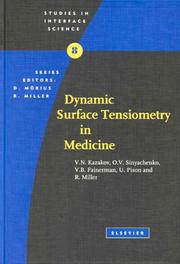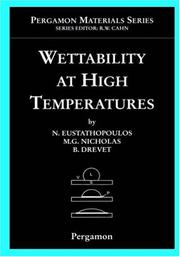| Listing 1 - 10 of 120 | << page >> |
Sort by
|
Multi
ISBN: 9780444821287 0444821287 9780080544656 0080544657 1281058254 9781281058256 9786611058258 Year: 1996 Publisher: Amsterdam ; New York : Elsevier,
Abstract | Keywords | Export | Availability | Bookmark
 Loading...
Loading...Choose an application
- Reference Manager
- EndNote
- RefWorks (Direct export to RefWorks)
This is the first monograph devoted to interfacial tensiometry and is therefore the definitive source of information on measuring surface tension. More than 40 methods for measuring surface tension both at the liquid-fluid and solid-fluid boundaries are described including methods using computational techniques, tele- and video-apparatus, and laser techniques. A central place in the book has been given to methods based on the investigation of properties of liquid and gaseous menisci both in the presence or absence of a gravitational field and a rotational one. Their description is preceded by
Book
ISBN: 1789846617 1789846609 Year: 2019 Publisher: London, England : IntechOpen,
Abstract | Keywords | Export | Availability | Bookmark
 Loading...
Loading...Choose an application
- Reference Manager
- EndNote
- RefWorks (Direct export to RefWorks)
Surface active agents. --- Surfactants --- Chemistry, Organic --- Surface tension --- Wetting agents
Book
ISBN: 163485621X 9781634856218 9781634856010 1634856015 Year: 2016 Publisher: New York
Abstract | Keywords | Export | Availability | Bookmark
 Loading...
Loading...Choose an application
- Reference Manager
- EndNote
- RefWorks (Direct export to RefWorks)
Surface active agents. --- Surfactants --- Chemistry, Organic --- Surface tension --- Wetting agents
Book
ISBN: 9535122150 9535166476 Year: 2015 Publisher: IntechOpen
Abstract | Keywords | Export | Availability | Bookmark
 Loading...
Loading...Choose an application
- Reference Manager
- EndNote
- RefWorks (Direct export to RefWorks)
On the liquid 's surface, the molecules have fewer neighbors in comparison with the bulk volume. As a result, the energy interaction shows itself in the surface tension. Traditionally, the surface tension can be assumed as a force in the unit of the length which can be counted by the unit of Newton on squared meter, or energy on the units of the surface. The surface tension, implies the interface between liquid and vapor, which is an example of the surface tensions. The equilibrium between these surface tensions, decides that a droplet on a solid surface, would have a droplet form or will change to layer form. This book collects new developments in wetting and wettability science.
Wetting. --- Surface chemistry --- Surface tension --- Surface Science --- Physical Sciences --- Engineering and Technology --- Materials Science --- Fluid Dynamics
Book
ISBN: 1838805397 1838805389 1838807136 Year: 2019 Publisher: IntechOpen
Abstract | Keywords | Export | Availability | Bookmark
 Loading...
Loading...Choose an application
- Reference Manager
- EndNote
- RefWorks (Direct export to RefWorks)
Wettability at the solid/liquid interface, its dynamics, tunability, the influence of operating parameters, surface and interfacial phenomena play an increasingly significant role in a wide variety of applications, for example, material processing, nanotechnology, oil recovery, oil spills, chemical leaching, water management, and disease transmission. Although a mature field, it is experiencing dramatic developments on several fronts with emerging applications in new fields. This book presents a collection of eight chapters on nanoscale wetting phenomena, oil extraction from reservoir rocks, the role of coatings, particle morphology, surface roughness and viscosity in metal processing, and practical applications of superhydrophobic behaviour in cell culturing, isolation, anti-icing, anti-reflective and anti-corrosion coatings in the transportation and optical devices fields.
Wetting. --- Surface chemistry --- Surface tension --- Physical Sciences --- Engineering and Technology --- Materials Science --- Fluid Mechanics
Book
ISBN: 3030700267 3030700259 Year: 2021 Publisher: Cham, Switzerland : Springer,
Abstract | Keywords | Export | Availability | Bookmark
 Loading...
Loading...Choose an application
- Reference Manager
- EndNote
- RefWorks (Direct export to RefWorks)
Surface active agents --- Analysis. --- Biodegradation. --- Surfactants --- Chemistry, Organic --- Surface tension --- Wetting agents
Book
ISBN: 1000037674 3731501481 Year: 2014 Publisher: KIT Scientific Publishing
Abstract | Keywords | Export | Availability | Bookmark
 Loading...
Loading...Choose an application
- Reference Manager
- EndNote
- RefWorks (Direct export to RefWorks)
In the production of modern components, e.g. displays, complex substrates with e.g. conducting paths and pre-structuring are liquid coated and dried. The surfaces of such layers have to have a very well specified quality, usual. Thus it is necessary to avoid the formation of surface structures. This work presents the elementary mechanism and describes a technique for visualization to investigate surface deformations due to Marangoni-Convection during thin film drying.
convection --- Filmtrocknung --- Konvektion --- Marangoni --- Oberflächendeformationthin film drying --- surface deformation --- Oberflächenspannung --- surface tension

ISBN: 9780444504111 0444504117 9780080530598 0080530591 1281038741 9786611038748 Year: 2000 Publisher: Amsterdam ; New York : Elsevier,
Abstract | Keywords | Export | Availability | Bookmark
 Loading...
Loading...Choose an application
- Reference Manager
- EndNote
- RefWorks (Direct export to RefWorks)
Human biological liquids contain numerous low- and high-molecular weight surfactants. The human organism contains interfaces with enormous surfaces. The physicochemical and biochemical processes taking place at these interfaces are extremely important for the vital functions of the organism as a whole, and the interfacial properties may reflect peculiarities of age and sex, health and disease. The present book is the first attempt to systematically present the results of dynamic and equilibrium surface tensions measurements of serum and urine samples that were obtained from healthy humans of v
Semiology. Diagnosis. Symptomatology --- Surface tension. --- Body fluids. --- Physiology, Pathological. --- Physical biochemistry.

ISBN: 0080421466 9786611071967 128107196X 0080543782 9780080543789 9780080421469 9781281071965 6611071962 Year: 1999 Publisher: Amsterdam ; New York : Pergamon,
Abstract | Keywords | Export | Availability | Bookmark
 Loading...
Loading...Choose an application
- Reference Manager
- EndNote
- RefWorks (Direct export to RefWorks)
The purpose of this book is to bring together current scientific understanding of wetting behaviour that has been gained from theoretical models and quantitative experimental observations. The materials considered are liquid metals or inorganic glasses in contact with solid metals or ceramics at temperatures of 200-2000oC. Wetting has been a significant scientific concern for the last two centuries and reference will be made to classical work by nineteenth century scientists such as Dupré, Laplace and Young that was validated by observations of the behaviour of chemically inert
Materials at high temperatures --- Wetting --- Surface chemistry --- Surface tension --- High temperatures --- Materials --- Strength of materials --- Materials at high temperatures. --- Wetting.
Book
ISBN: 3110437163 311044481X 9783110444810 9783110437164 3110444801 9783110444803 9783110258530 9783110258790 9783112203750 311025879X 9781680152067 1680152068 3110258536 Year: 2017 Publisher: Berlin Boston De Gruyter
Abstract | Keywords | Export | Availability | Bookmark
 Loading...
Loading...Choose an application
- Reference Manager
- EndNote
- RefWorks (Direct export to RefWorks)
The revealing of the phenomenon of superhydrophobicity (the "lotus-effect") has stimulated an interest in wetting of real (rough and chemically heterogeneous) surfaces. In spite of the fact that wetting has been exposed to intensive research for more than 200 years, there still is a broad field open for theoretical and experimental research, including recently revealed superhydrophobic, superoleophobic and superhydrophilic surfaces, so-called liquid marbles, wetting transitions, etc. This book integrates all these aspects within a general framework of wetting of real surfaces, where physical and chemical heterogeneity is essential. Wetting of rough/heterogeneous surfaces is discussed through the use of the variational approach developed recently by the author. It allows natural and elegant grounding of main equations describing wetting of solid surfaces, i.e. Young, Wenzel and Cassie-Baxter equations. The problems of superhydrophobicity, wetting transitions and contact angle hysteresis are discussed in much detail, in view of novel models and new experimental data.
Wetting. --- Surface tension. --- Capillarity. --- Surfaces (Technology) --- Materials --- Surface phenomena --- Friction --- Surfaces (Physics) --- Tribology --- Matter --- Physics --- Permeability --- Surface chemistry --- Surface tension --- Capillarity --- Liquids --- Surface energy --- Wetting --- Surfaces --- Properties --- Mouillage (chimie des surfaces) --- Tension superficielle. --- Capillarité. --- Surfaces (technologie) --- Hysteresis --- Solid-liquid interfaces --- Liquid-solid interfaces --- Interfaces (Physical sciences) --- Elasticity --- Magnetic induction --- Solid-liquid interfaces. --- Hysteresis. --- Cassie Wetting. --- Contact Angle Hysteresis. --- Electrowetting. --- Non Stick Droplets. --- Superhydrophobicity. --- Surface Tension. --- Surface Wetting. --- Wenzel Wetting. --- Wetting Dynamics. --- Wetting Transitions.
| Listing 1 - 10 of 120 | << page >> |
Sort by
|

 Search
Search Feedback
Feedback About UniCat
About UniCat  Help
Help News
News